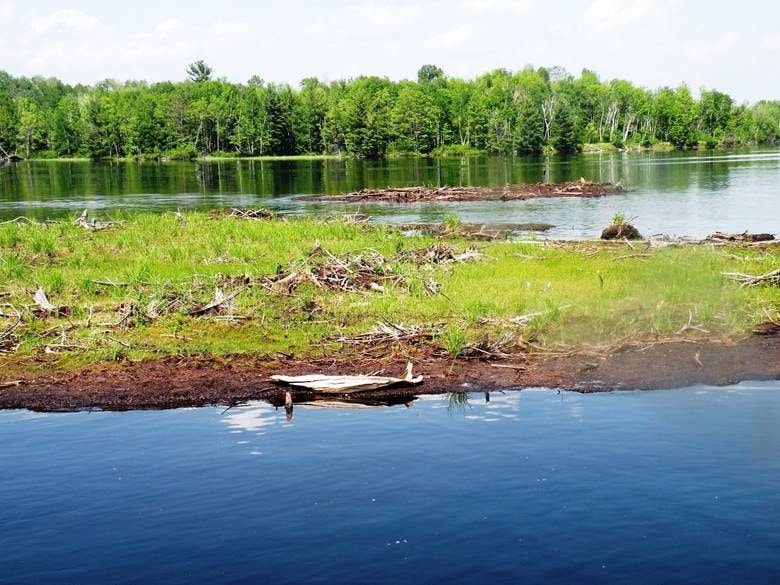Nestled in the heart of Wisconsin, Lake Chippewa, also known as the Chippewa Flowage, harbors a natural wonder that captivates the imagination and calls upon the spirit of community. It is here that a massive, floating landmass known as the ‘Forty Acre Bog’ embarks on its annual, unpredictable journey, often obstructing a vital bridge and prompting a remarkable display of human cooperation to restore passage.
The genesis of this floating island traces back to the lake’s creation in 1923, when a vast swamp was deliberately flooded. This event gave rise to numerous peat bogs, which, over time, surfaced and became fertile grounds for seeds dispersed by the whims of the wind and the diligent work of wild birds. As the seasons cycled, a diverse array of flora, from humble grasses to towering trees, took root and thrived, intertwining their fates with the buoyant peat below. These roots, ever-expanding, have not only anchored the life above but also contributed to the growth of the bogs themselves.

The ‘Forty Acre Bog’ stands as the largest among these floating islands, a testament to the power of nature’s persistence. Adorned with mature trees, it has become a symbol of the lake’s unique ecosystem. However, its size and mobility present a recurring challenge. Almost every year, the bog drifts perilously close to a bridge that serves as the sole connector between the East and West sides of Lake Chippewa. This bridge is not merely a convenience; it is a critical artery for the local community, facilitating travel, commerce, and emergency services.
When the bog sets its sights on this bridge, the local boat owners rise to the occasion. Dozens of them, in a display of unity and determination, band together to push the island away. This task is not for the faint of heart; it requires a keen understanding of the winds and a coordinated effort to maneuver the massive landmass. One local man’s words, as reported by Northern News Now, capture the essence of this endeavor: ‘It’s almost every year. It takes a community effort and you have to have the winds at your back in order to push them in.’
The Chippewa Flowage website offers further insight into the life cycle of these islands.
Initially, they emerge as mud flats from the depths of the once-swampy lakebed. Over time, as vegetation takes hold, the islands mature, with the oldest among them boasting trees that serve an unexpected purpose. When the wind catches their leaves and branches, it propels the entire floating mass across the lake’s surface, much like sails on a ship. This natural phenomenon adds a layer of unpredictability to the islands’ movements, making the task of predicting and preventing blockages all the more challenging.
Local resident Denny Reyes humorously reflects on the daily uncertainty brought about by the wandering bog: ‘It’s one of the first things you look for when you come in here in the morning: Where’s the bog?’ His words underscore the blend of curiosity and concern that the floating island evokes among those who call Lake Chippewa home.

The bog’s movement can quickly change from a wonder to a nuisance for locals.
The bridge it threatens to block is not just any bridge; it is the only passage between the two sides of the lake. When the bog looms near, the community has no choice but to take to their boats. And it is not a task for a single vessel, no matter how powerful. Instead, it requires a fleet, each boat contributing to the collective push, with the wind as their ally. The previous year saw the mobilization of 25 boats for this purpose, a testament to the scale of the operation and the commitment of the community.
The process of moving the bog is as much an art as it is a science.
Local homeowner Greg Kopke explains the delicate balance required: ‘When we move it, we gotta get it kind of in the right spot, or it can be back in in a couple of days.’ His words reveal the strategic nature of the task, where precision is key to ensuring the bog does not simply return to its problematic position.
Beyond its imposing presence and the logistical challenges it presents, the Forty Acre Bog is also a sanctuary for wildlife. As such, it is protected by law, and cannot be dismantled or destroyed. This legal protection underscores the ecological significance of the bog and the diverse life it supports. Ecologist Rudraksh Gupta highlights the importance of such habitats, noting that epiphytes like filmy ferns are excellent indicators of temperate rainforest ecosystems, which cover a mere 1% of the world’s surface, making them even rarer than tropical rainforests. The presence of such species on the bog is a reminder of the delicate balance between human activity and the preservation of natural habitats.
The Forty Acre Bog story mirrors humanity’s relationship with nature.
It is a dance of coexistence, where the forces of nature and the needs of a community converge. The bog’s annual drift and the subsequent rallying of local boat owners to redirect it serve as a powerful metaphor for the challenges we face in our relationship with the natural world. It is a reminder that, while we may have the ability to shape our environment, we are also at the mercy of its whims and must act responsibly to maintain harmony.
As we delve deeper into the tale of Lake Chippewa’s wandering island, we are reminded of the resilience of both nature and human communities. The Forty Acre Bog, with its majestic trees and floating mass, is a testament to the enduring power of growth and adaptation. The local boat owners, with their unwavering commitment to preserving the flow of life around the lake, embody the spirit of cooperation and stewardship. Together, they navigate the challenges posed by this remarkable phenomenon, ensuring that the bridge remains clear and the community connected.
Delving into the community effort surrounding the Forty Acre Bog, we uncover a narrative that is as much about human connection as it is about the ecological marvel of Lake Chippewa. The annual pilgrimage of boats that gather to steer the wandering island away from the bridge is a testament to the power of collective action. This section will explore the intricacies of this community effort, the legal and ecological considerations that protect the bog, and the broader implications of this unique interaction between humans and nature.
The community’s response to the drifting Forty Acre Bog is a dance of coordination and timing, with the wind playing a pivotal role. As one local man told Northern News Now, ‘It’s almost every year. It takes a community effort and you have to have the winds at your back in order to push them in.’ This statement encapsulates the essence of the task at hand: it is not merely a physical endeavor but also one that requires patience and an understanding of the natural forces at play.
The Chippewa Flowage website provides insight into the origins of these floating islands, which begin as mud flats and gradually become lush habitats as vegetation takes root. The oldest of these islands, like the Forty Acre Bog, have trees that act as sails, catching the wind and causing the entire mass to drift across the lake. This natural propulsion system adds a layer of complexity to the community’s efforts to control the bog’s movements.
Local resident Denny Reyes humorously reflects on the daily uncertainty brought about by the wandering bog, saying, ‘It’s one of the first things you look for when you come in here in the morning: Where’s the bog?’ His comment underscores the unpredictable nature of the bog and its impact on the daily lives of those who live near Lake Chippewa.
The bog move needs many boats working together.
Last year, 25 boats were used to push the floating island away from the bridge, highlighting the scale of the operation and the community’s dedication to maintaining access across the lake. Local homeowner Greg Kopke emphasizes the need for precision in this task, stating, ‘When we move it, we gotta get it kind of in the right spot, or it can be back in in a couple of days.’ This strategic approach is crucial to ensure the bog does not simply return to its obstructive position.
The legal protection of the Forty Acre Bog as a habitat for various animal species adds another layer to the story. These floating islands cannot be broken apart due to their ecological importance, which is further highlighted by ecologist Rudraksh Gupta’s commentary on epiphytes like filmy ferns. These plants serve as indicators of temperate rainforest ecosystems, which are rarer than tropical rainforests and cover only 1% of the world’s surface. The presence of such species on the bog is a reminder of the delicate balance between human activity and the preservation of natural habitats.
The community’s efforts to manage the bog’s position are a microcosm of the broader human experience with nature. It is a reminder that while we have the ability to shape our environment, we are also subject to its whims. The annual drift of the Forty Acre Bog and the subsequent rallying of local boat owners to redirect it serve as a powerful metaphor for the challenges we face in our relationship with the natural world.
The story of the Forty Acre Bog is one of resilience, adaptation, and community. It is a narrative that intertwines the lives of local residents with the rhythms of nature, showcasing the importance of cooperation and stewardship. As we reflect on this remarkable phenomenon, we are reminded of the enduring power of community and the need for harmony with the natural world that sustains us.
Related posts:
The Giant Floating Island of Lake Chippewa Has to Be Pushed by Boats Almost Every Year
The Story about Bogs – Chippewa Flowage – Lake Chippewa Flowage Resort Association





